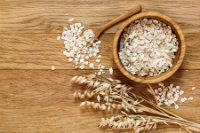Oat, My Goodness!
/Avena sativa, also called the common oat, is a grain full of healthy goodness. Oats are often used for breakfast cereal, oatmeal, granola and as a flour for baking breads and cookies. A dietary source to fuel the body, a 3.5 ounce serving of oats provides over 60 grams of carbohydrates, 16 grams of protein, and about 7 grams of fat.
Oats contain beta-glucans, which are known to decrease saturated fat in the blood and may reduce the risk of heart disease. Most people are familiar with oat as a medicinal food for its ability to regulate cholesterol.
Other important effects of having a serving of oats in your daily diet include: support for digestion, sexual health, and bone health, as well as enhancing energy and maintaining a positive mood. Oat is a fantastic source of dietary fiber, which helps maintain a healthy gut. Oat has been studied in the management of male sexual dysfunction as well as managing menstrual symptoms and regulating blood sugar levels. It's also an excellent source for B vitamins and the mineral manganese, which play important roles in physiological processes that support the health of mind and body.
If you are gluten sensitive be sure to look for gluten free oats.
Image Attribution: Ferumov/bigstockphoto.com
Reference





















